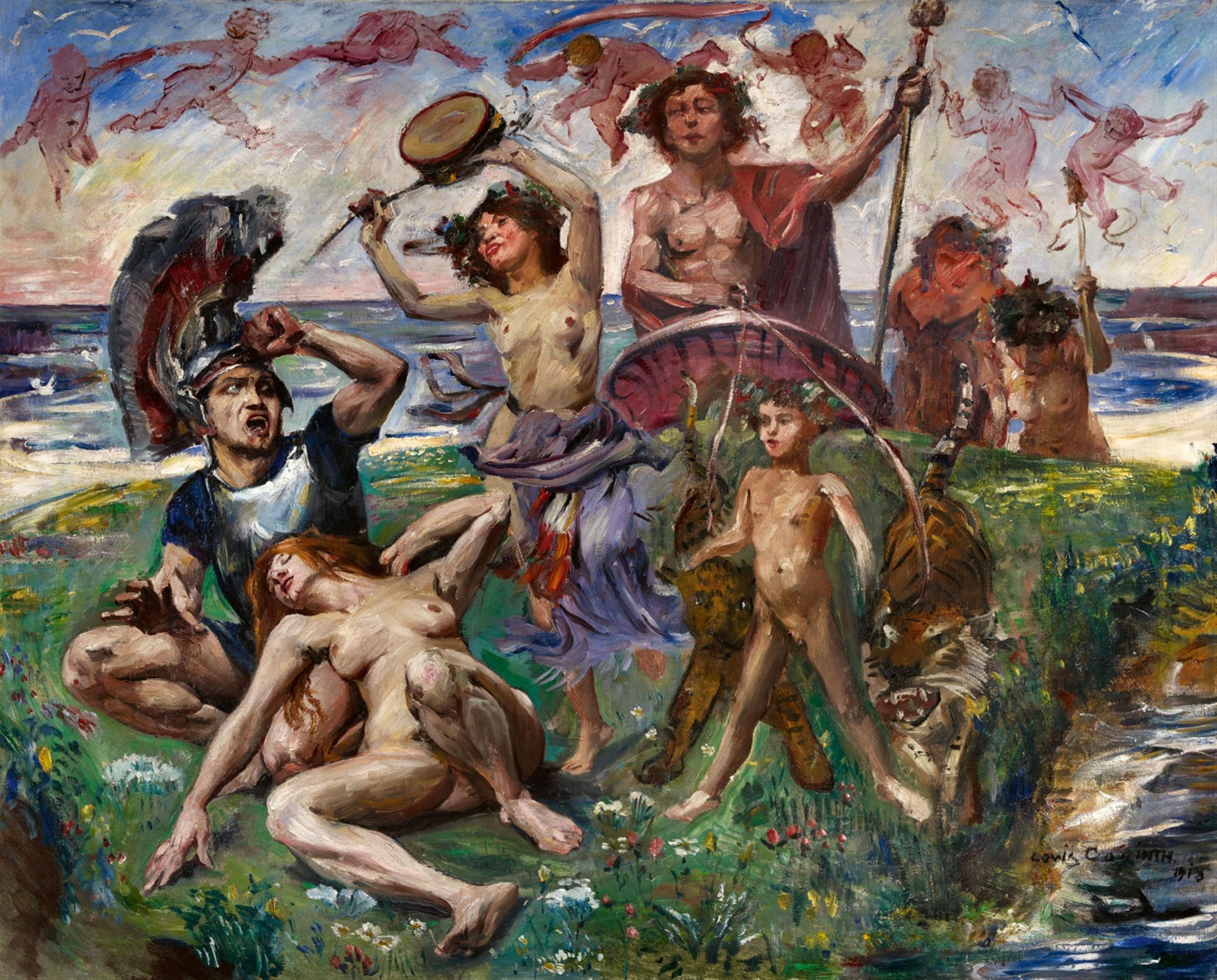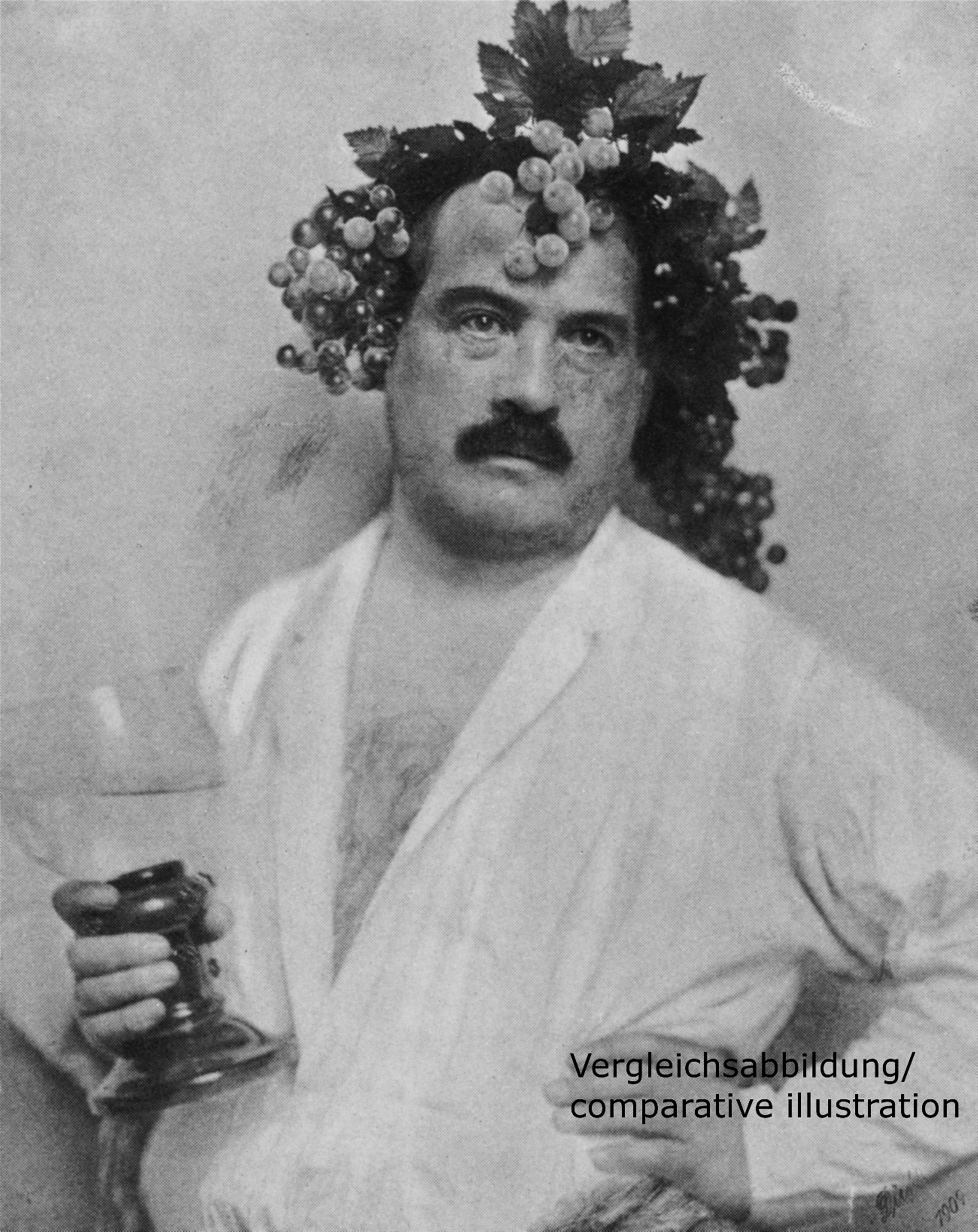Lovis Corinth
Ariadne auf Naxos
1913
Oil on canvas, relined 120.2 x 150.3 cm Framed. Signed and dated 'Lovis Corinth 1913' in black lower right. - Retouches.
In the mid-1880s, living in Paris and studying at the Académie Julian, which was renowned among artists from outside France, Lovis Corinth met the salon painters Tony Robert-Fleury and Adolphe William Bouguereau, who transferred important literary material into dramatically and minutely composed figural paintings. It was not the painting of the “modern” Impressionists which interested the young artist from Kaliningrad (then Königsberg): he persistently and tenaciously strove for official recognition from the richly historic Parisian Salon. In order to achieve this Corinth selected Biblical and mythological subjects at the beginning of his career: these included “Versuchung des Heiligen Antonius”, “Salome, Bacchanale” and “Heimkehrende Bacchanten”, which he would then paint repeatedly when he returned back to Munich and later in Berlin.
A 1912 composition by Richard Strauss with a libretto by Hugo von Hofmannsthal, originally planned for Max Reinhardt's theatre in Berlin, may have provided the stimulus for Corinth to gradually begin developing the epic “Ariadne auf Naxos”. Thus, in 1913, Corinth occupied himself with subjects from Greek mythology: he painted reclining female nudes, a veiled dancer and bacchants.
We recognise Dionysus - Bacchus in Roman mythology - as the focal point of our painting: in his chariot he enters on to the island from the vastness of the sea with the sweepingly dramatic gesture of his extended arm and accompanied by a procession of his ecstatically dancing and stumbling followers, consisting of raucous maenads and satyrs. The demigod Dionysus, offspring of Zeus and Semele, embodies the primal forces of sensual desire like no other divine figure of antique mythology - a brightly youthful hero with a grapevine garland and grapes in his long, curly hair. The god of fertility wandered the world in his panther-drawn triumphal chariot, giving the local inhabitants wine to drive away their worries and spreading viticulture to new places. Dionysus lived out his sensual lust in a number of love affairs prior to his decisive encounter with Ariadne, the subject narrated by our painting.
Corinth has concentrated on the moment of the first meeting between the demigod and daughter of a king on the Aegean island of Naxos. He interprets this scene in an unusual way by having Bacchus meet Ariadne sleeping in the arms of the victorious Theseus, who had vanquished the monstrous Minotaur on Crete with the help of a trick thought up by Ariadne. According to the narrative told in the legend, Theseus had already left the sleeping Ariadne, whom he had promised to marry; here, in Corinth's interpretation, he is confronted with his rival's power and triumphal arrival on Naxos. The god of wine fell in love in the sleeping daughter of the king and chose her for his bride. The story also relates how he threw her diadem up into the sky: in Corinth's work the gems transform into exuberantly dancing putti before mutating into the constellation Corona Borealis.
Corinth has painted a monumental scene depicting the triumphal procession of love and the profusion of life it brings with it. He seems to participate in this dramatic event like a witness who was there to see it - just as he repeatedly concealed himself in the figure of Dionysus (or Bacchus) in order to recreate his life of excess (see comparative illus.).
Catalogue Raisonné
Berend-Corinth 569
Provenance
Alfred Krupp, Essen; Arndt von Bohlen und Halbach, Munich; Weinmüller, Munich 16 March 1972, lot 1521; Sotheby's Frankfurt 1988; Christie's London, 3 April 1990, lot 347 with colour illus.; Kunstsalon Franke, Baden-Baden; Private collection, South Germany
Literature
Kunst für Alle, vol. 28 1913, p. 460; Georg Biermann, Lovis Corinth, Bielefeld/Leipzig 1922, p. 117 with illus. no. 128; Weltkunst, 1990/16, p. 2323 with illus.
Exhibitions
Berlin 1913 (Berliner Sezession), 26. exhibition, no. 256; Berlin 1918 (Berliner Sezession), no. 64; Berlin 1923 (Nationalgalerie), no. 67; Baden-Baden 1990 (Kunstsalon Franke), cat. no. 34 with colour illus.; Munich/Berlin/Saint Louis/London 1996/1997 (Haus der Kunst/Nationalgalerie/The Saint Louis Art Museum/Tate Gallery), Lovis Corinth, cat. no. 105, p. 218 with colour illus.




